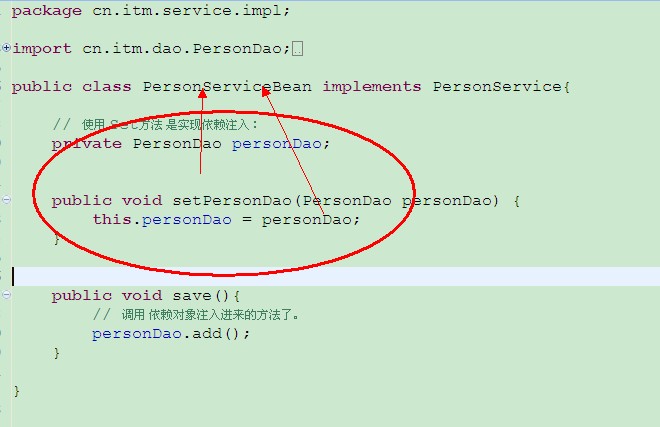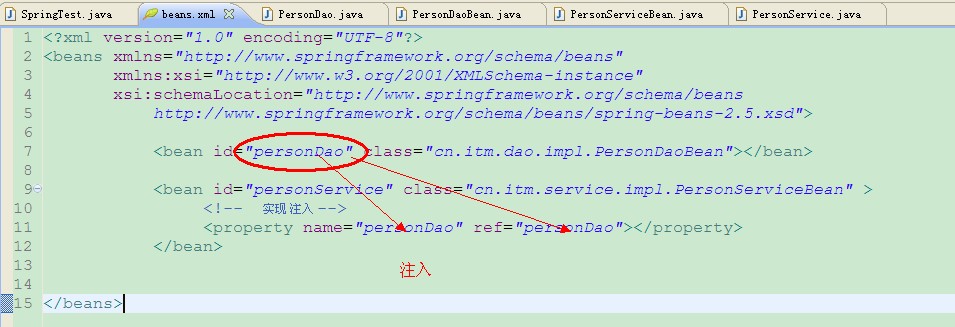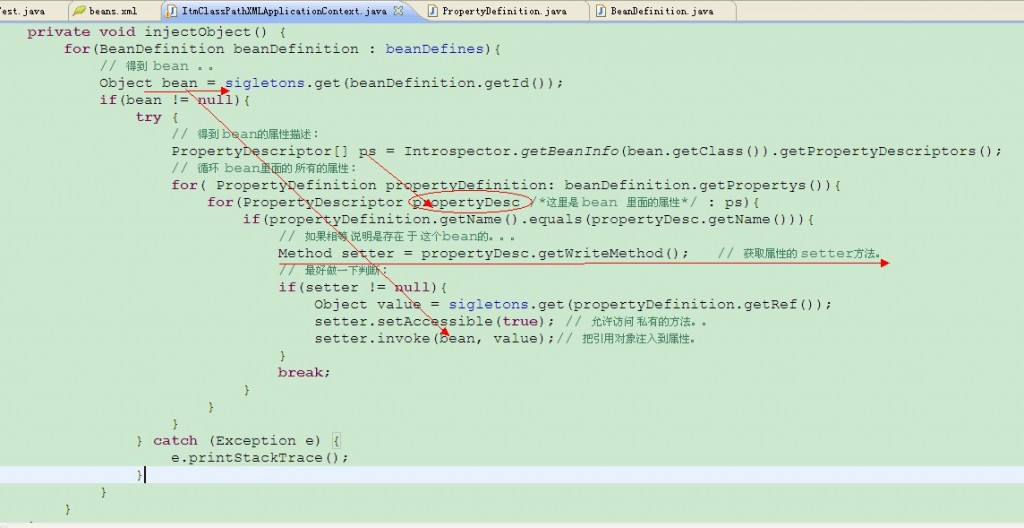(4) 利用 Setter方式实现 【第一种方式】 依赖注入,编码剖析Spring依赖注入的原理
来源:互联网 发布:dlna软件 编辑:程序博客网 时间:2024/05/29 09:53
import cn.itm.dao.PersonDao;public class PersonDaoBean implements PersonDao {public void add(){System.out.println("执行PersonDaoBean的add方法。。。");}}package cn.itm.dao;public interface PersonDao {public abstract void add();}
package cn.itm.service.impl;import cn.itm.dao.PersonDao;import cn.itm.service.PersonService;public class PersonServiceBean implements PersonService{// 使用 Set方法 是实现依赖注入:private PersonDao personDao;public void setPersonDao(PersonDao personDao) {this.personDao = personDao;}public void save(){// 调用 依赖对象注入进来的方法了。personDao.add();}}package cn.itm.service;public interface PersonService {public abstract void save();}<?xml version="1.0" encoding="UTF-8"?><beans xmlns="http://www.springframework.org/schema/beans" xmlns:xsi="http://www.w3.org/2001/XMLSchema-instance" xsi:schemaLocation="http://www.springframework.org/schema/beans http://www.springframework.org/schema/beans/spring-beans-2.5.xsd"> <bean id="personDao" class="cn.itm.dao.impl.PersonDaoBean"></bean> <bean id="personService" class="cn.itm.service.impl.PersonServiceBean" > <!-- 实现 注入 --> <property name="personDao" ref="personDao"></property> </bean> </beans>

测试类:
package junit.test;import org.junit.BeforeClass;import org.junit.Test;import org.springframework.context.ApplicationContext;import org.springframework.context.support.ClassPathXmlApplicationContext;import cn.itm.service.PersonService;public class SpringTest {@BeforeClasspublic static void setUpBeforeClass() throws Exception {}// 专门用来实例化 Spring 容器的。@Test public void instanceSpring(){ApplicationContext ctx = new ClassPathXmlApplicationContext("beans.xml");PersonService personService = (PersonService) ctx.getBean("personService");personService.save();}}成功。
利用setter方式的好处:可以被多个bean使用。
下面利用编码剖析Spring依赖注入的原理:
package junit.test;import java.beans.Introspector;import java.beans.PropertyDescriptor;import java.lang.reflect.Method;import java.net.URL;import java.util.ArrayList;import java.util.HashMap;import java.util.List;import java.util.Map;import org.dom4j.Document;import org.dom4j.Element;import org.dom4j.XPath;import org.dom4j.io.SAXReader;public class ItmClassPathXMLApplicationContext {private List<BeanDefinition> beanDefines = new ArrayList<BeanDefinition>();// 存放实例private Map<String,Object> sigletons = new HashMap<String,Object>();public ItmClassPathXMLApplicationContext(String fileName){this.readXML(fileName);this.instanceBeans();this.injectObject();}private void injectObject() {for(BeanDefinition beanDefinition : beanDefines){// 得到 bean 。。Object bean = sigletons.get(beanDefinition.getId());if(bean != null){try {// 得到 bean的属性描述:PropertyDescriptor[] ps = Introspector.getBeanInfo(bean.getClass()).getPropertyDescriptors();// 循环 bean里面的 所有的属性:for( PropertyDefinition propertyDefinition: beanDefinition.getPropertys()){for(PropertyDescriptor propertyDesc /*这里是 bean 里面的属性*/ : ps){if(propertyDefinition.getName().equals(propertyDesc.getName())){// 如果相等 说明是存在 于 这个bean的。。。Method setter = propertyDesc.getWriteMethod(); // 获取属性的 setter方法。// 最好做一下判断:if(setter != null){Object value = sigletons.get(propertyDefinition.getRef());setter.setAccessible(true); // 允许访问 私有的方法。。setter.invoke(bean, value);// 把引用对象注入到属性。}break;}}}} catch (Exception e) {e.printStackTrace();}}}}/** * 通过反射技术,完成 bean 的实例化: */private void instanceBeans() {for(BeanDefinition beanDefinition : beanDefines){try {if(beanDefinition.getClassName() != null && !"".equals(beanDefinition.getClassName().trim())){sigletons.put(beanDefinition.getId(), Class.forName(beanDefinition.getClassName()).newInstance());}} catch (Exception e) {e.printStackTrace();}}}/** * 读取 XML 的配置文件: * @param fileName */@SuppressWarnings("unchecked")private void readXML(String fileName) {// 创建读取器:SAXReader saxReader = new SAXReader();Document document = null;try{URL xmlPath = this.getClass().getClassLoader().getResource(fileName);document = saxReader.read(xmlPath); // 读取文件的内容。。。Map<String,String> nsMap = new HashMap<String,String>();nsMap.put("ns", "http://www.springframework.org/schema/beans"); // 加入命名空间// 创建beans/bean 查询路径。XPath xsub = document.createXPath("//ns:beans/ns:bean"); // 设置命名空间。xsub.setNamespaceURIs(nsMap); // 获取文档下 所有bean节点:List<Element> beans = xsub.selectNodes(document);for(Element element : beans){String id = element.attributeValue("id"); // 获取id属性值。String clazz = element.attributeValue("class"); // 获取 class 属性值。BeanDefinition beanDefine = new BeanDefinition(id, clazz);// 查询的相对路径:XPath propertysub = element.createXPath("ns:property");propertysub.setNamespaceURIs(nsMap);// 设置命名空间。List<Element> propertys = propertysub.selectNodes(element);for(Element property : propertys){String propertyName = property.attributeValue("name");String propertyRef = property.attributeValue("ref");System.out.println(propertyName + "==" + propertyRef);PropertyDefinition propertyDefinition = new PropertyDefinition(propertyName, propertyRef);// 放到 bean里面去:beanDefine.getPropertys().add(propertyDefinition);}beanDefines.add(beanDefine);}}catch(Exception e){e.printStackTrace();}}/** * 获取 bean实例 * @param beanName * @return */public Object getBean(String beanName){return this.sigletons.get(beanName);}}
本文源自:学习 传智播客黎活明老师的视频 自己总结而至。
- (4) 利用 Setter方式实现 【第一种方式】 依赖注入,编码剖析Spring依赖注入的原理
- (3) 利用 Setter方式实现 【第一种方式】 依赖注入,编码剖析Spring依赖注入的原理
- 编码剖析Spring依赖注入的原理
- 编码剖析Spring依赖注入的原理
- (4) 编码剖析Spring装配基本属性的原理【附加:注入依赖对象的两种方式】
- spring-依赖注入的实现方式
- Spring的两种依赖注入方式:setter方法注入与构造方法注入
- Spring 依赖注入原理、Spring 依赖注入两种方式
- Spring依赖注入的方式
- spring-依赖注入的方式
- spring依赖注入的方式
- spring依赖注入的方式
- Spring的依赖注入方式
- spring的依赖注入方式
- Spring的依赖注入方式
- Spring、Spring依赖注入与编码剖析Spring依赖注入的原理
- Spring依赖注入方式
- Spring依赖注入方式
- linux 日志创建及备份
- ObjC利用正则表达式抓取网页内容
- 内联汇编优化的TAlpha::FillSolidColor 部分汇编
- 数组没隔两个数删除一个数最后循环求最后删除数的下标
- Android Handler和ThreadHandler
- (4) 利用 Setter方式实现 【第一种方式】 依赖注入,编码剖析Spring依赖注入的原理
- Bézier曲线(翻译)
- Linux内核网络协议栈笔记1:协议栈分层/层次结构
- 关于张老师Java视频学习(六)
- JSP的执行过程
- 数据库设计理论及应用(4)——概念结构设计
- C/C++位运算
- dirname(__FILE__)的意思
- 保险行业CRM解决方案


